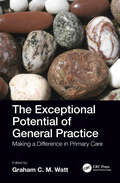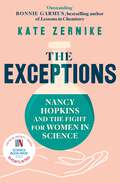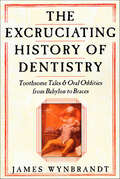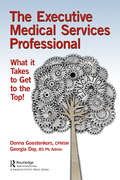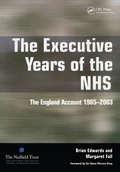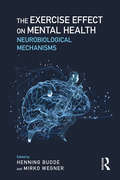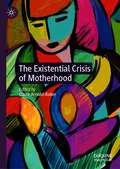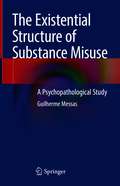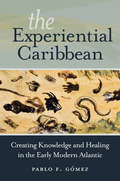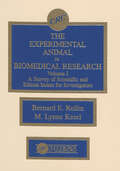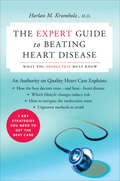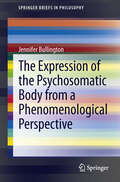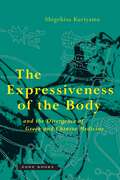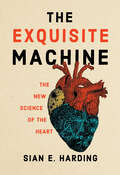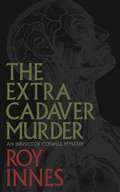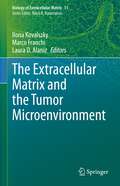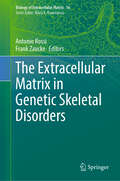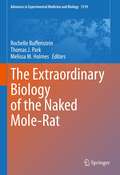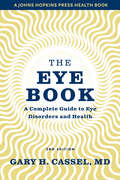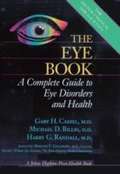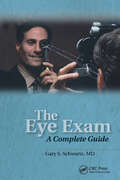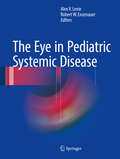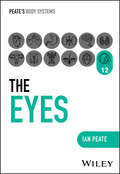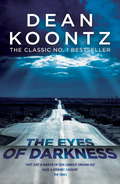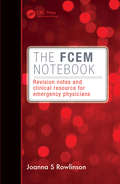- Table View
- List View
The Exceptional Potential of General Practice: Making a Difference in Primary Care
by Graham WattThis innovative and timely book draws on pioneering precedents, basic principles, current examples and international experience to capture the narratives, examples and ideas that underlie and demonstrate the exceptional potential of general practice: <P><P>"If health care is not at is best where it is needed most, health inequalities will widen." <P><P>"The unworried unwell are not hard to reach but they are easy to ignore and are often ignored." <P><P>"With patient contact, population coverage, continuity, coordination, flexibility, long term relationships and trust, general practices are the natural hubs of local health systems." <P><P>"… practitioners … are not only scientists but also responsible citizens and if they did not raise their voice who else should?" <P><P>Written for family doctors looking to strengthen local collaboration, it brings together the traditional strengths of consultations, caring, continuity, coordination and coverage with the current and future challenges of building capacity, community, creativity, consistency, collegiality and campaigning. It highlights the critical importance of working with patients, maximising the use of serial encounters, integrating care, joint working between practices, social prescribing, community development and advocacy based on patient and practitioner experience. <P><P>Drawing on the highly-regarded work of Deep End GPs serving the poorest communities in Scotland ̶ www.gla.ac.uk/deepend ̶ the book is an invaluable handbook for all primary care doctors, irrespective of health care system or country, seeking to provide unconditional continuity of personalised care for all patients, whatever problem or combination of problems a patient may have.
The Exceptions: Nancy Hopkins and the fight for women in science
by Kate Zernike&‘Outstanding&’ Bonnie Garmus, bestselling author of Lessons in ChemistryThe remarkable untold story of how a group of sixteen determined women used the power of the collective and the tools of science to inspire ongoing radical change. This is a triumphant account of progress, whilst reminding us that further action is needed. These women scientists entered the work force in the 1960s during a push for affirmative action. Embarking on their careers they thought that discrimination against women was a thing of the past and that science was a pure meritocracy. Women were marginalized and minimized, especially as they grew older, their contributions stolen and erased. Written by the Pulitzer Prize-winning journalist who broke the story in 1999 for The Boston Globe, when the Massachusetts Institute of Technology made the astonishing admission that it discriminated against women on its faculty, The Exceptions is an intimate narrative which centres on Nancy Hopkins – a surprisingly reluctant feminist who became a hero to two generations of women in science. In uncovering an erased history, we are finally introduced to the hidden scientists who paved the way for collective change.
The Excruciating History of Dentistry: Toothsome Tales & Oral Oddities from Babylon to Braces
by James WynbrandtAn “entertaining history” of the practice of dentistry that will remind you how lucky you are to live in the modern era (Publishers Weekly).For those on both sides of the dreaded dentist’s chair, James Wynbrandt has written a witty, colorful, and richly informative history of the art and science of dentistry. To all of those dental patients whose whine rises in tandem with that of the drill, take note: You would do well to stifle your terror and instead offer thanks to Apollonia, the patron saint of toothache sufferers, that you face only fleeting discomfort rather than the disfiguring distress or slow agonizing death oft meted out by dental-care providers of the past. The transition from yesterday’s ignorance, misapprehension, and superstition to the enlightened and nerve-deadened protocols of today has been a long, slow, and very painful process—as shown by such facts as:*Among the toothache remedies favored by Pierre Fauchard, the father of dentistry, was rinsing the mouth liberally with one’s own urine.*George Washington never had wooden teeth. However, his chronic dental problems may have impacted the outcome of the American Revolution.*Soldiers in the Civil War needed at least two opposing front teeth to rip open powder envelopes. Some men had their front teeth extracted to avoid service.*Teeth were harvested from as many as fifty thousand corpses after the Battle of Waterloo, a huge crop later used for dentures and transplants that became known as “Waterloo Teeth.”“You’ll gain a great deal of dental knowledge, acquired quite painlessly.” —The New York Times Book Review“Just the thing you need to get through your next oral probing.” —Entertainment Weekly“A breezy romp . . . While sensitive dentists may wince at having their profession’s rough-and-tumble past revealed, dental patients are more likely to feel relief at having been born in the modern era of dentistry. Both groups are in for a good laugh.” —Kirkus Reviews
The Executive Medical Services Professional: What It Takes to Get to the Top!
by Donna Goestenkors Georgia DayMedical Services Professionals (MSPs) hold a unique place in the healthcare industry. Medical Staff leaders, practitioners and providers rely on MSPs to ensure qualitative regulatory compliance, performance improvement, accreditation, credentialing and governance for physicians, practitioners, and other healthcare providers. MSPs ensure the design, implementation, and maintenance of current industry practices to promote quality patient care. Their roles are rapidly changing due to competition, increased government influence, and vast changes in technology that demand for service delivery improvements worldwide. The successful MSP will require a formal professional development plan, comprised of skills and knowledge for both personal and career choices as the industry moves into the future. This book is presented in an easy to read format and contains a series of building blocks, "points" to navigate career progression logically. Each point highlights solutions for MSPs to test and apply with real-life stories interspersed to illustrate points. This book contains a helpful glossary, sample job descriptions, and terms specific to the MSP.
The Executive Years of the NHS: The England Account 1985-2003
by Brian Edwards Margaret FallA guide to clinical effectiveness and governance, this second edition includes clinical governance issues. It aims to increase awareness of, and skills in, an evidence-based approach to health care, and there is advice on collecting, evaluating, interpreting and applying evidence.
The Exercise Effect on Mental Health: Neurobiological Mechanisms
by Henning Budde Mirko WegnerThe Exercise Effect on Mental Health contains the most recent and thorough overview of the links between exercise and mental health, and the underlying mechanisms of the brain. The text will enhance interested clinicians’ and researchers’ understanding of the neurobiological effect of exercise on mental health. Editors Budde and Wegner have compiled a comprehensive review of the ways in which physical activity impacts the neurobiological mechanisms of the most common psychological and psychiatric disorders, including depression, anxiety, bipolar disorder, and schizophrenia. This text presents a rigorously evidence-based case for exercise as an inexpensive, time-saving, and highly effective treatment for those suffering from mental illness and distress.
The Existential Crisis of Motherhood
by Claire Arnold-BakerThis book offers a new perspective on the motherhood experience. Drawing on existential philosophy and recent phenomenological research into motherhood, the book demonstrates how motherhood can be understood as an existential crisis. It argues that an awareness of the existential issues women face will enable mothers to gain a deeper understanding of the multifaceted aspects of their experience. The book is divided into four sections: Existential Crisis, Maternal Mental Health Crisis, Social Crisis and Working with Existential Crisis, where each section. Each chapter is based on either experiential research or the author’s extensive therapeutic experience of working with mothers and reflects different aspects of the motherhood journey, all through the lens of a philosophical existential approach. The book is essential reading for mental health practitioners and researchers working with mothers, midwives and health visitors, but it is also written for mothers, with the aim to offer new insights on this important life transition.
The Existential Structure of Substance Misuse: A Psychopathological Study
by Guilherme MessasThis book contributes to one of the most challenging areas of mental health: substance misuse. Its focus is on the psychopathological experiences associated with it: both the consequences of substance misuse and the existential vulnerabilities that lead to it, even if such a clear-cut distinction is rarely possible. The work brings an innovative perspective to the issue, as it draws on two scientific fields whose association has not yet been fully explored: phenomenological psychopathology and substance misuse studies. The association of these two perspectives could build a greater understanding of this important topic and be of practical help to a wide array of professionals in their clinical practice. The structure of the book is inspired by this overall perspective. Its division into three parts is designed to introduce the reader, in a stepwise manner, to the complexities of the theme, based on the latest advances in the specific literature. The broad objective of this work is therefore to offer a useful instrument for mental health clinicians, psychiatrists, psychologists, nurses, undergraduate students of these disciplines, and all substance abuse workers.
The Experiential Caribbean: Creating Knowledge and Healing in the Early Modern Atlantic
by Pablo F. GómezOpening a window on a dynamic realm far beyond imperial courts, anatomical theaters, and learned societies, Pablo F. Gomez examines the strategies that Caribbean people used to create authoritative, experientially based knowledge about the human body and the natural world during the long seventeenth century. Gomez treats the early modern intellectual culture of these mostly black and free Caribbean communities on its own merits and not only as it relates to well-known frameworks for the study of science and medicine.Drawing on an array of governmental and ecclesiastical sources—notably Inquisition records—Gomez highlights more than one hundred black ritual practitioners regarded as masters of healing practices and as social and spiritual leaders. He shows how they developed evidence-based healing principles based on sensorial experience rather than on dogma. He elucidates how they nourished ideas about the universality of human bodies, which contributed to the rise of empirical testing of disease origins and cures. Both colonial authorities and Caribbean people of all conditions viewed this experiential knowledge as powerful and competitive. In some ways, it served to respond to the ills of slavery. Even more crucial, however, it demonstrates how the black Atlantic helped creatively to fashion the early modern world.
The Experimental Animal in Biomedical Research: A Survey of Scientific and Ethical Issues for Investigators, Volume I
by Bernard E. RollinThe Experimental Animal in Biomedical Research provides a concise, useful survey of knowledge regarding laboratory animal care. Volume I addresses researchers who use animals and focuses on how to maximize the welfare of animals used in research.
The Expert Guide to Beating Heart Disease: What You Absolutely Must Know
by Harlan M. KrumholzWhat Do the Best-Trained Doctors Do to Beat Heart Disease?In today's avalanche of medical information, how can you distinguish between proven evidence and unfounded claims? This is the first book to translate key medical data into clear guidelines capturing the highest treatment standards for heart disease. Renowned cardiovascular expert Dr. Harlan Krumholz presents seven strategies for reducing cardiac risk—what professionals agree really works. In this indispensable handbook, he also profiles care alternatives from supplements to stress reduction as well as treatments on the horizon. A "Tools for Success" section helps you track blood pressure, cholesterol, exercise, and weight.
The Expression of the Psychosomatic Body from a Phenomenological Perspective
by Jennifer BullingtonThis book is a contribution to the understanding of psychosomatic health problems. Inspired by the work of the French phenomenologist Maurice Merleau-Ponty, a phenomenological theory of psychosomatics is worked out as an alternative to traditional, biomedical thinking. The patient who presents somatic symptoms with no clearly discernible lesion or dysfunction presents a problem to the traditional health care system. These symptoms are medically unexplainable, constituting an anomaly for the materialistic understanding of ill health that underlies the practice of modern medicine. The traditional biomedical model is not appropriate for understanding a number of health issues that we call "psychosomatic" and for this reason, biomedical theory and practice must be complemented by another theoretical understanding in order to adequately grasp the psychosomatic problematic. This book establishes a complementary understanding of psychosomatic ill health in terms of a non-reductionistic model allowing for the (psychosomatic) expression of the lived body. A thorough presentation of the work Merleau-Ponty is followed by the author's application of his thinking to the phenomenon of psychosomatic pathology.
The Expressiveness of the Body and the Divergence of Greek and Chinese Medicine
by Shigehisa KuriyamaAn illuminating account of how early medicine in Greece and China perceived the human bodyWinner of the William H. Welch Medal, American Association for the History of MedicineThe true structure and workings of the human body are, we casually assume, everywhere the same, a universal reality. But when we look into the past, our sense of reality wavers: accounts of the body in diverse medical traditions often seem to describe mutually alien, almost unrelated worlds. How can perceptions of something as basic and intimate as the body differ so? In this book, Shigehisa Kuriyama explores this fundamental question, elucidating the fascinating contrasts between the human body described in classical Greek medicine and the body as envisaged by physicians in ancient China. Revealing how perceptions of the body and conceptions of personhood are intimately linked, his comparative inquiry invites us, indeed compels us, to reassess our own habits of feeling and perceiving.
The Exquisite Machine: The New Science of the Heart
by Sian E. HardingHow science is opening up the mysteries of the heart, revealing the poetry in motion within the machine.Your heart is a miracle in motion, a marvel of construction unsurpassed by any human-made creation. It beats 100,000 times every day—if you were to live to 100, that would be more than 3 billion beats across your lifespan. Despite decades of effort in labs all over the world, we have not yet been able to replicate the heart&’s perfect engineering. But, as Sian Harding shows us in The Exquisite Machine, new scientific developments are opening up the mysteries of the heart. And this explosion of new science—ultrafast imaging, gene editing, stem cells, artificial intelligence, and advanced sub-light microscopy—has crucial, real-world consequences for health and well-being. Harding—a world leader in cardiac research—explores the relation between the emotions and heart function, reporting that the heart not only responds to our emotions, it creates them as well. The condition known as Broken Heart Syndrome, for example, is a real disorder than can follow bereavement or stress. The Exquisite Machine describes the evolutionary forces that have shaped the heart&’s response to damage, the astonishing rejuvenating power of stem cells, how we can avoid heart disease, and why it can be so hard to repair a damaged heart. It tells the stories of patients who have had the devastating experiences of a heart attack, chaotic heart rhythms, or stress-induced acute heart failure. And it describes how cutting-edge technologies are enabling experiments and clinical trials that will lead us to new solutions to the worldwide scourge of heart disease.
The Extra Cadaver Murder (Inspector Coswell of the RCMP #4)
by Roy InnesRCMP Inspector Coswell is back. A university professor is murdered and his corpse is revealed to a first year anatomy class in spectacular fashion—nude on a slab alongside shrouded medical cadavers. He begins his investigation with Corporal James, his long time assistant, but is abruptly assigned a new partner, a female officer who arrives under a political cloud. Already depressed by his perceived plunge into senility, Coswell struggles to stifle his own gender biases and work effectively with this woman. Their list of suspects grows: failed students, a jealous colleague, an intriguing ex-wife and a criminal cartel. Clues emerge that send them all over the city of Vancouver from UBC campus to downtown and its gourmet restaurants.
The Extracellular Matrix and the Tumor Microenvironment (Biology of Extracellular Matrix #11)
by Ilona Kovalszky Marco Franchi Laura D. AlanizThis book introduces the most important and best studied extracellular and pericellular molecules of the tumor microenvironment. It gives a comprehensive overview of their role in tumor development and cancer progression.Twelve chapters deal with the biochemical and biophysical background of extracellular matrix (ECM) changes in the tumor stroma compared to the physiological state. The reader learns about the major ECM components that are deregulated during cancer development and how they are associated with cancer progression associated with survival, inflammation process, among others. These are followed by recent data about the cooperative activity of extracellular matrix in tumor metabolism, promoting cancer progression.Two chapters focus specifically on the critical role of the ECM in tumor angiogenesis, linking this process to cellular infiltration and metastatic behavior of tumors. The final part describes how the ECM influences the success of immuno- and chemotherapy in cancer patients, its potential as biomarkers for diagnosis, prognosis, and therapeutic target, as well as the mechanism of resistance-associated changes in the ECM. This book is an interesting read for anyone who want to know more about ECM and cancer biology. Early career scientists can use it as an introduction to the field, offering an excellent tool for studying ECM. Advanced researchers and clinicians can gain a broader overview of the subject, considering the role of ECM for influencing every cancer hallmark as well as in the response of cancer treatments. The work serves to inspire future research and shows that the ECM should be considered as an important factor in the development of cancer therapeutics. The series "Biology of Extracellular Matrix" is published in collaboration with the American Society for Matrix Biology and the International Society for Matrix Biology.
The Extracellular Matrix in Genetic Skeletal Disorders (Biology of Extracellular Matrix #16)
by Antonio Rossi Frank ZauckeThis book explores how defects in extracellular matrix (ECM) proteins, their post-translational modifications, and intracellular trafficking impact cartilage and bone integrity. It underscores the ECM's role in providing structural support, establishing morphogenetic gradients, and interacting with cell surface receptors in musculoskeletal tissues. The book delves into the structure and biology of the ECM in the skeleton, discussing skeletal disorders caused by mutations in genes associated with ECM proteins, synthesis, turnover, and signal transduction. Authored by experts who have made significant discoveries in the molecular mechanisms of skeletal disorders and are developing therapeutic strategies, this book is an invaluable research for both scientists and clinicians seeking a comprehensive understanding of this growing and exciting field. The series Biology of Extracellular Matrix is published in collaboration with the American Society for Matrix Biology and the International Society for Matrix Biology.
The Extraordinary Biology of the Naked Mole-Rat (Advances in Experimental Medicine and Biology #1319)
by Rochelle Buffenstein Thomas J. Park Melissa M. HolmesThis volume focuses on the huge advances in the last 25 years on the use of this animal model for biomedical research (cancer, heart disease and neurodegeneration), fundamental neuroscience and basic subterranean biology. In 2013, Science magazine named the naked mole-rat as the Vertebrate of the Year. This was partly due to research carried out documenting its extreme longevity, negligible senescence, and prolonged maintenance of cancer free, good health well into old age as well as seminal work on mechanisms involved in these processes, pain and hypoxia resistance. In addition to this research focus on longevity and chronic diseases such as cancer and cardiovascular disease, the naked mole-rat has also made a substantial contribution to the fields of ecophysiology, neuroscience and behavior. With international contributions, this book provides a valuable text for zoological students, behavioral scientists and biomedical researchers.
The Eye Book: A Complete Guide to Eye Disorders and Health (A Johns Hopkins Press Health Book)
by Gary H. CasselThe Owner's Manual for Your Eyes: The most comprehensive guide to taking care of vision.In The Eye Book, specialist Dr. Gary H. Cassel presents readers with trusted, evidence-based information they can rely on to protect vision and learn more about how to treat any eye problems that come up. This easy-to-understand volume takes a step-by-step approach, providing an overview of the eye's anatomy, a tour of healthy vision, and an explanation of what steps readers and health care providers should take to address vision issues. Drawing on years of clinical experience with patients, Cassel also looks at eye complications associated with common medical conditions (for example, diabetes) along with the best treatments for eye conditions, such as cataracts and glaucoma.Now in its second edition, this bestselling book continues to provide the interested reader, along with nurse practitioners, physician assistants, internists, and family doctors, with practical information about • eyeglass materials, contact lenses, and refractive surgeries (including LASIK) to improve vision• tips to spot and treat common eye irritations and infections, including conjunctivitis ("pink eye") • advice about when people should take care of an eye problem on their own and when they need to consult with an expert • what people (and their health care providers) can do about blurriness, dry eyes, eye strain, eye allergies, and floaters • how vision problems may be a sign of other health conditions, including thyroid problems and multiple sclerosis• which medications may affect vision• what people within and outside of the medical field need to know about macular degeneration and low visionRichly illustrated and engagingly written, this edition features special bonus material, including a chapter on cosmetics and the eye, FAQs ("Can cataracts grow back after cataract surgery?"; "Will I go blind from my glaucoma?"), and a handy symptom index that allows readers to research topics by the presentation of an eye problem. Useful for everyone, including general medical professionals who want to learn more about the health of the eyes, this up-to-date, in-depth, and authoritative book will serve as a users' manual for the eyes and help promote better vision for a brighter tomorrow.
The Eye Book: A Complete Guide to Eye Disorders and Health (Johns Hopkins Press Health)
by Gary H. Cassel Michael D. Billig Harry G. Randall Morton F. Goldberg Wilmer Eye Institute StaffWhen all is well with our eyes, most of us take them for granted. But when our vision is blurred or our eyes are itchy and watery, it's hard to concentrate on anything but our eyes. In The Eye Book, three eye care specialists present a comprehensive reference to help readers care for their eyes and protect their vision, with special attention to changes and diseases that occur in the adult years. After detailing how the various parts of the eye work together so we can see, the authors review everything that can go wrong—from myopia, hyperopia, and astigmatism to the major disorders of cataracts, glaucoma, and age-related macular degeneration. They also thoroughly describe each part of the eye and the problems that can develop, from the irritation of itchy eyelids and conjunctivitis to emergency situations such as a detached retina. They describe the signs and symptoms of all these problems and how to deal with them, including when to apply a warm compress—and when to head to the emergency room. Medical and surgical treatment of both minor eye irritations and major diseases are explained in detail, so readers know where to turn and what to expect. The authors also tell readers what happens during an eye examination and how to recognize an eye emergency. They explain all about eyeglasses, including the various kinds of bifocals, and describe the care and maintenance of contact lenses in a way that makes wearing them a viable option for anyone who wishes to do so. They detail the special concerns of people with systemic diseases such as diabetes and indicate how common medications—from antibiotics and antidepressants to tamoxifen—affect the eyes. The pros and cons of refractive surgery are discussed, as are the special problems of people with low vision. An appendix lists medications used to treat eye conditions and the side effects of those medications. The book is fully illustrated with fifty-five line drawings and includes a symptoms index that will direct readers to sections of the book which describe the possible causes of the specific symptoms they are experiencing.
The Eye Exam: A Complete Guide
by Gary S. SchwartzThe Eye Exam: A Complete Guide is a handy reference with a primary focus on developing history and exam skills for all professionals working with patients in the eye clinic.Written in an easy and practical format, The Eye Exam presents the proper way to perform a history and physical examination on an eye patient. The opening chapters will educate the reader on how to perform an eye history on adults, as well as special indications and techniques for examining children. Also included are chapters on the foundation of basic optics and how to perform a proper distance and near refraction exams. The Eye Exam concludes with how to perform various examination techniques and how to record the findings.Dr. Gary Schwartz includes only the essential information about ophthalmic examinations, so that the reader is not bogged down with unnecessary information about diseases and treatments.The Eye Exam is perfect for the eye clinic novice wanting to learn the basics and be proficient with performing routine eye exams, as well as the experienced clinician looking to enrich existing skills and understanding of the eye exam techniques.Physical Exam Topics Include: Subjective and objective refraction Near refraction Color vision Pupil exam Motilities Alignment Slit lamp examination Intraocular pressure determination Gonioscopy Retina examination Additional features: Helpful question and answer sections at the end of most chapters Common abbreviations used in the eye clinic Eye medications Surgical procedures A pocket guide of the necessary components of the basic eye history and physical exam
The Eye in Pediatric Systemic Disease
by Alex V. Levin Robert W. EnzenauerThis book is the first of its kind to describe ocular manifestations of systemic diseases in the pediatric population. Written and edited by experts in areas of pediatric ophthalmology and genetics, this new text covers a multitude of topics in a comprehensive and catalogued fashion. The Eye in Pediatric Systemic Disease is designed as an in depth and up-to-date reference work that is heavily referenced, thus allowing the reader ready access to the international supporting literature. Everything from ocular manifestations of hematologic disease, child abuse, psychiatric diseases, renal disorders, and vitamin disorders are covered, allowing readers to know what to look for in the eyes of children with a given systemic disorder. The Eye in Pediatric Systemic Disease is written in language that is accessible to ophthalmologists and pediatricians, as well as allied health care professionals. Because of this, it will be an essential textbook for use in community pediatric and ophthalmology practices, academic centers, and training programs.
The Eyes (Peate's Body Systems)
by Ian PeatePEATE’S BODY SYSTEMS THE EYES A CONCISE, ILLUSTRATED, AND ACCESSIBLE GUIDE TO THE EYES Each of the twelve volumes in Peate’s Body Systems series is rooted in the belief that a deep and thorough understanding of the human body is essential for providing the highest standard of care. Offering clear, accessible and up-to-date information on different body systems, this series bridges the gap between complex scientific concepts and practical, everyday applications in health and care settings. This series makes for an invaluable resource for those committed to understanding the intricacies of human biology, physiology and the various systems that sustain life. The Eyes is the perfect companion for students and newly registered practitioners across nursing and allied health fields with an interest in eye care, providing a comprehensive yet easy-to-digest guide for both academic and clinical application. Equips healthcare students and practitioners with the necessary information to provide safe and competent careFeatures colourful illustrations to aid comprehension, clarify complicated concepts, and render content more engaging and accessibleEmpowers readers to adapt to a rapidly evolving healthcare landscape, preparing them for the future of healthcare deliveryContains information necessary for effective patient care of those with glaucoma, cataract, macular degeneration, and other eye diseases and conditions
The Eyes of Darkness: A gripping suspense thriller that predicted a global danger...
by Dean KoontzA search for a missing son... and a toxic mystery that threatens the globe. 'Did a 1981 Dean Koontz thriller predict the coronavirus outbreak?' Daily Mail'Dean Koontz is not just a master of our darkest dreams, but also a literary juggler' The TimesFrom bestselling phenomenon Dean Koontz, The Eyes of Darkness is a gripping thriller following a mother's search for her son - a journey that unlocks the deadliest of secrets. It's a year since Tina Evans lost her little boy Danny in a tragic accident. Then a shattering message appears on the blackboard in Danny's old room: NOT DEAD. Is it someone's idea of a grim joke? Or something far more sinister?The search for an answer drives Tina through the neon clamour of Las Vegas nightlife. The sun-scorched desert. The frozen mountains of the High Sierra. People face a dreadful danger as a buried truth struggles to surface. A truth so frightening that its secret must be kept at the price of any life - any man, any woman...any child. Why readers are obsessed with The Eyes of Darkness: 'Couldn't put it down...it's been a while since a book has kept me up all night.' ***** Goodreads review'So prophetic I really can't believe it.' ***** Goodreads review'It is simply unbelievable.' ***** Goodreads reviewThis book was originally published under the pseudonym Leigh Nichols.
The FCEM Notebook: Revision notes and clinical resource for emergency physicians
by Joanna RowlinsonThe FCEM Notebook: Revision Notes and Clinical Resource for Emergency Physicians is the essential guide to passing the Fellowship of the College of Emergency Medicine (FCEM) examination. The book contains short questions related to the FCEM curriculum along with succinct answers to allow candidates to test their knowledge. Also included are current
